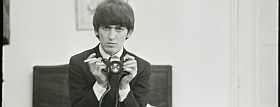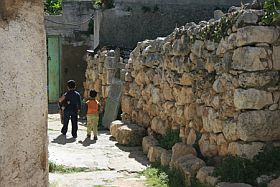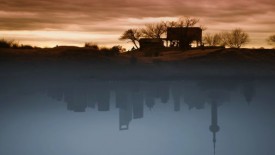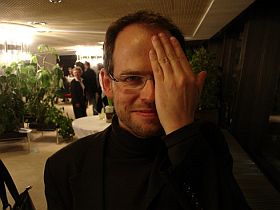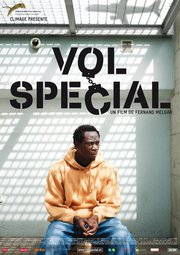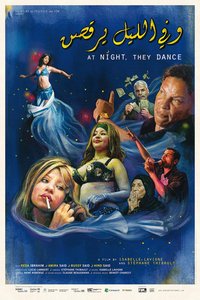Tonight the awards of the 54th DOK Leipzig festival were announced. A new record total of 74,500 euros (!) in prize money was granted to a total of 17 awards. The total prize list follows below. The three international competition films that I highlighted in posts below were not given one single prize… well, of course all respect for a jury, also when it makes wrong decisions!
Positive it is that Wojciech Staron gets the Silver Dove for “The Argentinian Lesson” (photo). I was heading the jury in Cracow this year in June where the beautiful film got the first prize after no discussion at all. Also to be saluted is the decision of the Talent Competition Jury that had three fine films on their list, “Life in Stills” by Israeli Tamar Tal, “Phnom Penh Lullaby” by Polish Pawel Kloc and “Bakhmaro” by Georgian Salome Jashi – although the order could have been different, in my opinion. And bravo to the MDR, the local broadcaster for awarding “The Day I will forget” by Russian Alina Rudnickaja. Will they also broadcast it? Here is the list, received this evening:
The International Jury for Documentary Film awards for Documentary Films and Videos / Long Metrage (longer than 45 min) a Golden Dove along with € 10 000 granted by TELEPOOL GmbH to Tatiana Huezo (Mexico) for the film El lugar más pequeno (The Tiniest Place) and a Silver Dove along with € 3 000 to Wojciech Staroń (Poland) for the film Argentyńska lekcja (Argentinean Lesson). The International Jury for Documentary Film awards an Honorary
Mention to Aliona van der Horst (The Netherlands) for the film Water Children.
The German Jury for Documentary Film awards for Documentary Films and Videos a Golden Dove along with € 10 000 to Katharina Pethke (Germany) for the film Louisa.
The International Jury for the Young Talent Competition awards for an extraordinary documentary film talent the Talent Dove of the Media Foundation of the Sparkasse Leipzig along with € 10 000 as start-up funding for the next documentary film project to Tamar Tal (Israel) for the film Hatzalmania (Life in Stills). The International Jury for the Young Talent Competition awards for an extraordinary documentary film talent an Honorary Mention to Pawel Kloc (Poland) for the film Phnom Penh Lullaby and an Honorary Mention to Salome Jashi (Germany, Georgia) for the film Bakhmaro.
The International Jury for Documentary Film awards for Documentary Films and Videos / Short Metrage (to 45 min) a Golden Dove along with € 5 000 to Julian Schwanitz (UK) for the film Kirkcaldy Man. The International Jury for Documentary Film awards for Documentary Films and Videos / Short Metrage (to 45 min) an Honorary Mention to Alina Rudnickaja (Russia) for the film Ja zabudu etot den’ (I Will Forget This Day).
The Jury for the Healthy Workplaces Film Award awards for the best documentary film about the subject of work the Healthy Workplaces Film Award along with € 8 000 granted by the European Agency for Safety and Health at Work (EU OSHA) to Carmen Losmann (Germany) for the film Work Hard – Play Hard.
The Jury for the Stiftung Friedliche Revolution awards for the best documentary about the subject of democracy the Filmpreis “Leipziger Ring” along with € 5 000 granted by the Stiftung Friedliche Revolution to anonymous (France) for the film Fragments d’une révolution (Fragments of a Revolution).
The DEFA Foundation awards for an outstanding German documentary film the DEFA Sponsoring Prize as a grant in the amount of € 4 000 to Martin Gerner (Germany) for the film Generation Kunduz – Das Leben der Anderen (Generation Kunduz – The War of the Others).
The MDR (Mitteldeutscher Rundfunk) awards for an excellent Eastern European documentary film the MDR Film Prize along with € 3 000 to Alina Rudnickaja (Russia) for the film Ja zabudu etot den’ (I Will Forget This Day).
The Jury of the Department of Media and Arts in the Trade Union ver.di awards the Prize of the Trade Union ver.di along with € 2 500 to Tatiana Huezo (Mexico) for the film El lugar más pequeno (The Tiniest Place).
The Jury of the Goethe-Institut awards the Goethe-Institut Documentary Film Prize along with € 2 000 to Hannes Lang (Germany, Italy) for the film Peak
The Ecumenical Jury awards the Prize of the Ecomenical Jury comprising € 2 000 by the VCH-Hotels Germany GmbH – in the “Verband Christlicher Hoteliers e.V.” including the Hotel MICHAELIS in Leipzig to Carmen Losmann (Germany) for the film Work Hard – Play Hard.
The FIPRESCI jury awards the Prize to Carmen Losmann (Germany) for the film Work Hard – Play Hard.
The Youth Jury of the Filmschule Leipzig e. V. awards the Prize of the Youth Jury of the Filmschule Leipzig e. V. to Iris Olsson and Ives Niyongabo (Finland) for the film Sydämeni Taakka (Burden of My Heart)
www.dok-leipzig.de



